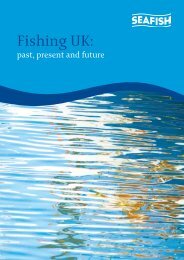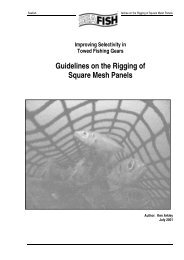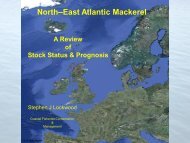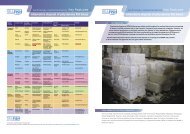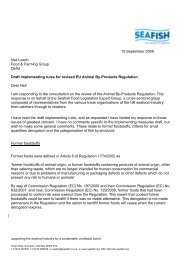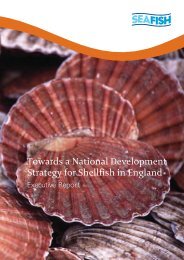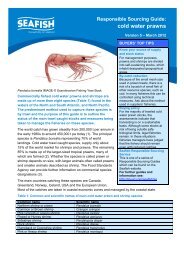You also want an ePaper? Increase the reach of your titles
YUMPU automatically turns print PDFs into web optimized ePapers that Google loves.
2 Species Guide – <strong>Gurnards</strong>. March 2011 v2.<br />
Biology<br />
<strong>Gurnards</strong> are able to grunt or growl by using<br />
muscles associated with the swim bladder<br />
and this is believed to aid in keeping schools<br />
together. They feed on benthic crustaceans,<br />
other invertebrates and bottom-dwelling<br />
fishes.<br />
Fisheries and gears<br />
Red gurnard is mainly caught in a mixed<br />
fishery by otter trawlers. Tub and grey<br />
gurnard are mainly taken as a bycatch in<br />
mixed demersal fisheries for flatfish and<br />
roundfish.<br />
However the market for gurnard is limited and<br />
they are often thrown back into the sea as an<br />
unwanted bycatch and subsequently<br />
discarded. Surveys indicate that this species<br />
is one of the most widely discarded (3).<br />
Stock assessment and catches<br />
There are no formal assessments or advice<br />
on gurnards However, there are a number of<br />
sources of information on these species and<br />
their role in the ecosystem (4,5,6).<br />
According to landings statistics the annual<br />
catches in the North East Atlantic from 2006-<br />
2009 have been (2):<br />
Tonnes 2006 2007 2008 2009<br />
Red 5171 5175 4778 4055<br />
Tub 2995 3416 2510 3058<br />
Grey 529 399 317 438<br />
There are uncertainties in landings data and<br />
some nations do not discriminate between<br />
the species in the landings data.<br />
Red gurnard – French fishing vessels land<br />
the most red gurnard and it is data from these<br />
and research vessels which provide the best<br />
time series for this species. Information is<br />
available for the Bay of Biscay, Celtic Sea,<br />
Western Approaches, English Channel and<br />
North Sea. Most of these time series indicate<br />
fluctuations in abundance without trends, with<br />
the exception of the North Sea where there<br />
appears to have been an upward trend in the<br />
last decade.<br />
Tub gurnard – As for red gurnard, French<br />
trawl fisheries and research vessel data<br />
provide the best time series for this species.<br />
Information is available for the Bay of Biscay,<br />
Celtic Sea, Western Approaches, English<br />
Channel and North Sea. Most of these results<br />
indicate fluctuation in abundance without<br />
trend with some evidence of increasing<br />
numbers of tub gurnard overwintering in the<br />
North Sea in recent years. This effect has<br />
been observed with other species such as<br />
red mullet which until recently did not<br />
overwinter in the North Sea.<br />
Grey gurnard – Due to their low commercial<br />
value there is widespread discarding of this<br />
species so only research vessel data can be<br />
considered a valid source of information. The<br />
research vessel surveys in the North Sea<br />
show a marked increase in abundance over<br />
the period 1987-2009, and relatively stable,<br />
though fluctuating abundance in the<br />
Skagerrak and Kattegat.<br />
Ecological aspects<br />
<strong>Gurnards</strong> are key predators in the North Sea<br />
and their importance is considered to have<br />
increased over recent years (4).<br />
Sustainability<br />
Taken together the information described<br />
above suggests that gurnard populations are<br />
relatively robust; that is current exploitation is<br />
not likely to seriously affect their abundance.<br />
Responsible Sourcing Services<br />
This guide is one of a series of <strong>Seafish</strong><br />
Responsible Sourcing Guides.<br />
See:<br />
http://www.tinyurl.com/seafishrsg






